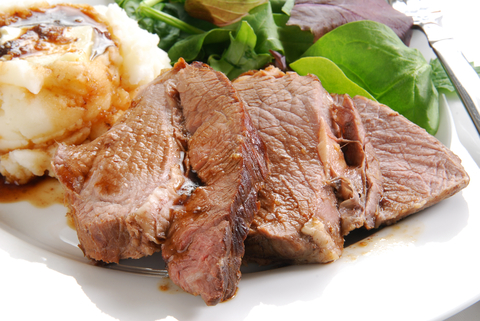
Making roast beef and then later adding all the trimmings is something that we can all do easily and make as healthy or as unhealthy as we want it to be.
Even adding something as simple as a Yorkshire Pudding can make it a dish that everyone would love to sit down to.
Getting roast beef cooked properly is actually easier than most people think it is.
Once it’s cooked, it can be used for a full meal, with salad, mashed, roast or boiled potatoes, or even sliced and added to sandwiches for a fabulous packed lunch.
Choose a Good Cut of Beef
I’d personally choose a rib of beef or a fillet to roast, but there are other options.
- Beef should look mature and have been well hung.
- There should be some fat to allow for flavour and to keep the roast moist while it’s cooking. It can be cut off before it is served up.
- There should be some marbling through the roast to help keep the roast moist.
Cooking Times
I’d recommend going by the times of your cooker as they can change, or be different from cooker to cooker. As a general rule of thumb, a very hot oven around 220C to start off with for the first 30 minutes in a pre-heated oven.
Lower the temperature of the oven for the rest of the cooking time to about 190 – 200C.
I check my meat by using a thermometer and put it right into the thickest part of the meat.
Options are approximately:
- Rare – (130-140F) The middle of the meat is a bright red hue and pinky towards the outside.
- Medium – (145-150F). The outside of the meat will be brown with a pinky centre and the roast will be hot.
- Well Done – (160-175F) As we prefer our meat well done here, I am usually looking for my roast to be brown throughout.
These cooking times and heats are a guide for example only. Guide temperatures can change depending on who is cooking and the roast you have picked. Make sure you follow manufacturers and suppliers instructions to make sure your meat is safely stored, cooked and eaten.
How to Cook Roast Beef
- Rest your beef for an hour before cooking it.
- It should be roasted in a tin big enough to catch any juice drip that might happen. Completely encase the roast in tin foil and loosely close it.
- Once the meat is cooked, it again needs to rest. Use the aluminium foil and make a loose parcel shape over the top and leave the roast to rest for about 15-20 minutes to get the most out of the meat.
- Pour off any excess juice for making gravy and your roast is ready to carve and serve with your accompaniments.